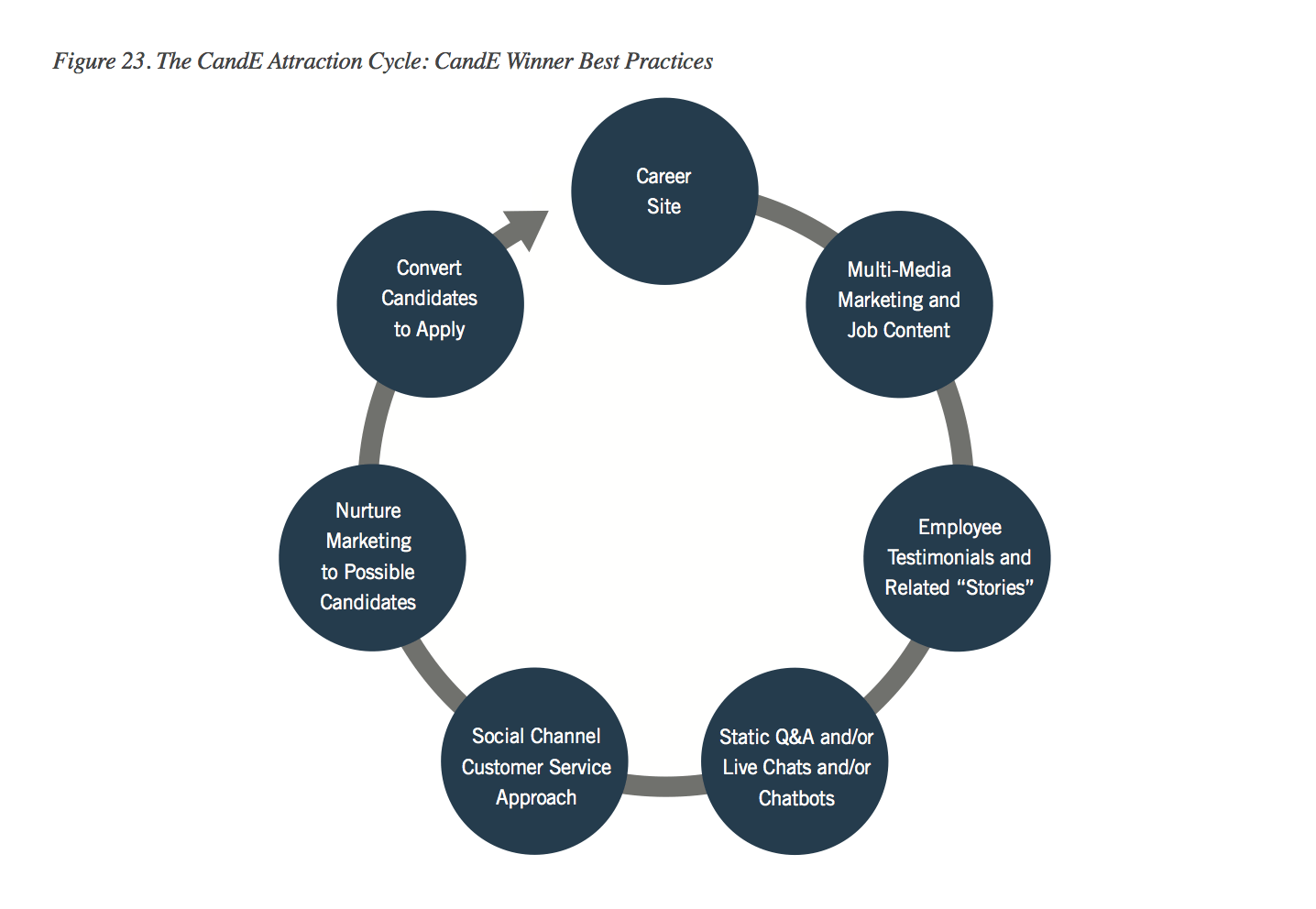Best Practices from the Talent Board’s Candidate Experience Award Winners

The Talent Board’s 2017 Candidate Experience (CandE) award winners are out, and with it comes the Board’s studies on a variety of best practices that companies are using to attract the best talent. If you want the hard numbers, last week’s overview can be found here. Right now we’ll be looking at what top performers are doing to enrich their candidate experience. Companies that create a good candidate experience are doing more than just improving their hiring processes. They’re improving their company brand, talent pool, and ultimately their bottom line.
CandE awards are given to employers who provide excellent candidate experiences, regardless of whether the candidate is hired. Businesses with leading candidate experiences consistently received top marks from the 180,000 candidates surveyed by the Talent Board. These companies and organizations range from Delta Air Lines and T-Mobile to the Northeast Ohio Regional Sewer District.
CandE award winners distinguish themselves from the competition at every step of the recruitment process; they attract top talent with high quality branding, screen and interview that talent with a smooth and friendly process, and close the hire with competitive offers.
Attract Phase
The attraction phase, arguably the most important in finding quality applicants, incorporates a number of different interacting components. CandE award winners have distinctly different approaches to this phase than their competition, from ditching the traditional tools to embracing new ones. When only 55 percent of candidates view a job description as the most important source of information on the job, these companies are finding ways to inform their talent pools without a lengthy list of responsibilities.
CandE winners treat their employer brand as a business and understand that candidates are their customers. They allow candidates to see inside their company and provide them with more than just a blanket job description. Their career pages include employee testimonials and show off the company culture as a place candidates want to be and can see themselves in. They also are more engaged in social media to find and engage talented candidates before the competition.
CandE winners aren’t just relying on job boards, they’re taking a multi-front approach to tackling their talent needs — image via The Talent Board
More importantly, CandE winners encourage feedback and communication with applicants. Communication doesn’t start when candidates are in an ATS. It can begin simply from reaching out to passive candidates. Just under one third of companies with positive experiences asked their applicants for feedback before they even applied while 79 percent of one star-rated companies provided no feedback opportunities at all.
These companies are aware that candidates can get insight into a position, organization, and culture long before they enter the application process. They are capitalizing on image management to get the best talent possible.
Application Phase
As companies transition from attracting and engaging talent to moving them into their ATS, there are ways that CandE winners break away from the rest of the pack.
It’s important to note that one third of candidates were applying horizontally, from hourly positions to hourly positions. These candidates are significantly less likely to apply to companies with cumbersome and time-consuming processes as it takes time out of an already busy day.
- 32 percent of candidates with one star reviews said that the process was difficult and cumbersome
- 58 percent of candidates with five star reviews said that the process was fast and efficient
CandE winners are also more flexible and more engaged with applicants from the start of the application process. Applicants are able to save their progress and pick it up later and can visibly see their progress from start to finish. They also use application tools like video interviews or virtual assessments that let applicants show off skills instead of check off boxes or prove they aren’t going to steal from the company.
Finally, and most importantly, CandE winners are conscious of their application processes and willing to make adjustments when things aren’t working. They put themselves into their applicants shoes and ask hard questions about whether or not they’d like to apply to a position. This comes from, you guessed it, feedback from candidates about what they liked or disliked.
Interview Phase
Applicants have high standards during the screening and interview step of the hiring process. Despite this, they are largely ignored until the time comes to inform them that they are or are not being moved forward. Only one in five candidates surveyed received notification that saying that they weren’t being considered, and the majority of those — 64 percent — did not get more detailed feedback and were not solicited for feedback about their experience.
The less time employers spend on their candidates and communication, the poorer it reflects in their branding. According to the Talent Board, providing communication and preparation for candidates makes for a dramatically better experience.
When it came to highest ranked candidate experiences, almost 40 percent of five star rated companies provided an agenda before the interview and almost half included the names and background of the interviewers. 59 percent of one star companies provided their candidates with a location, time, and nothing else.
If a business creates an interviewing environment where candidates feel like they aren’t valued as people, its employer brand will take a hit. On the other hand, candidates who feel like their time and professionalism are respected are more likely to reapply or refer other qualified talent.
Undisputable data; candidates with good experiences are more likely to
refer other talented candidates — graph via The Talent Board
When interviewing, CandE winners generally show a difference in their treatment of applicants. They prepare candidates with information about whom they are interviewing with and what they can expect. They provide their candidates with follow up and next steps. They ask questions that let candidates detail their skills and experience.
Once again, CandE winners separate themselves from others with feedback. While feedback can be limited by laws and internal regulations, these companies find ways to provide it.
- 27 percent of applicants that gave five star ratings received general and limited feedback from their assessments and interviews
- 26 percent received thorough and specific feedback.
- One third of applicants with positive impressions of the process were solicited for their feedback.
- 85 percent of applicants with a poor experience were asked for no feedback.
Hire Phase
The hiring phase is often left out of an organization’s candidate experience efforts. While it’s easy to think that the recruiting experience is finished after receiving an offer, there are a few details that will maximize a candidate’s impression of the process.
The two major factors in the candidate experience at this stage were the time between the final interview and when the organization extended an offer. 23 percent of candidates that rated their experience one star needed to wait longer than four weeks for an offer. As with attracting and screening, companies and organizations that offered their new hires a chance to provide feedback received better marks from their candidates.
Wrapping up
From all of this data the simplest, clearest trend is that companies that are transparent and treat their candidates like customers provide far better candidate experiences than their competition. While it’s easy to look at the candidate experience as a luxury or negative expense, don’t forget that silver-medal candidates and even those screened out earlier will reconsider applying again after a good experience, and will be more likely to refer colleagues to similar jobs. The evidence is in that by taking steps to improve their candidate experiences, companies are improving their talent pools and by assocation, their bottom line.



